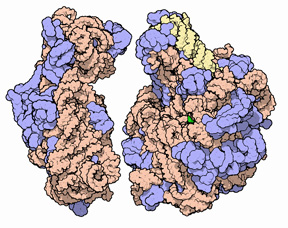Our laboratory studied one aspect of these programmed errors involving changes in the reading frame used during translation: programmed translational frameshifting. Random errors in reading frame occur extremely rarely during translation however some genes include sites that increase the frequency of frameshifting by several orders of magnitude. These “programmed frameshift sites”, manipulate the translational apparatus to promote non-canonical decoding, and therefore provide tools to probe the mechanism by which the translational apparatus maintains frame during elongation. We have studied the mechanism of frameshifting in a lower eukaryote, the yeast Saccharomyces cerevisiae. Frameshifting occurs when the ribosome, the RNA•protein machine responsible for translating nucleic acid sequences into protein, changes the frame it uses in reading the 3 nucleotide mRNA sequences called codons that specify which amino acid should be inserted. Such a shift causes the ribosome to read the same RNA sequence but to produce a totally different protein product.

Viruses, transposable genetic elements and a few known cellular genes use this mechanism to encode alternative forms of proteins. We have studied a family of transposable elements in the yeast Saccharomyces cerevisiae, called Ty elements, that use programmed frameshifting. We find that Ty frameshifting occurs as part of a dual-error mechanism in which the ribosome first recruits the wrong tRNA to read an in-frame codon, and this errant tRNA then induces the ribosome to recognize the next codon in the shifted reading frame. We are actively engaged in determining the mechanism of this dual-error, and in finding the molecular factors which are responsible for its efficiency.